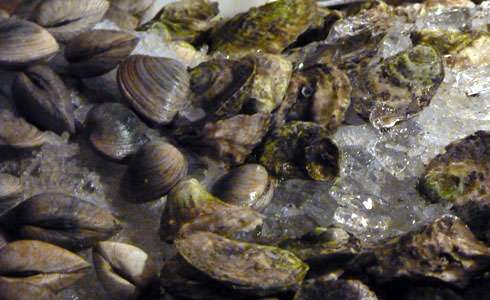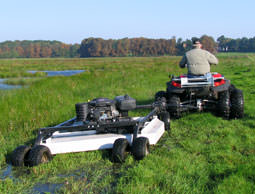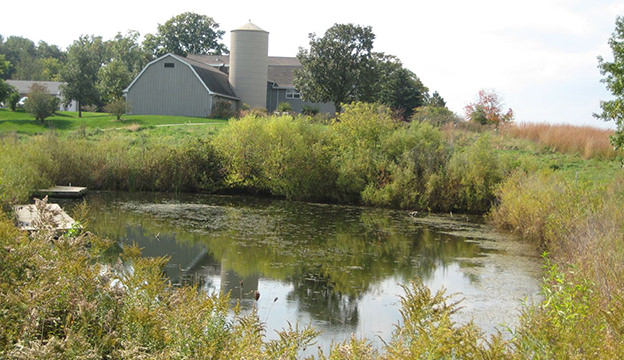Ponds are a staple of the farm landscape. Many have a primary purpose of watering livestock or providing irrigation for crops, but they can easily double as high-quality fisheries with proper construction and management. Nothing is more “country” than a lazy afternoon of fishing on the farm. It’s fun for young and old, and a farm pond full of fish provides the added benefit of farm-raised food for the table.
Managing an existing farm pond or creating the right pond is the key to years of enjoyment. On the other hand, poor pond construction or the wrong pond choice can not only be frustrating, but it can quickly become a money pit.
Preparing for a Farm Pond
Look for some basic features to turn an existing farm pond into a fish pond. The pond should be at least 1 acre in size. Smaller ponds can work, but pose some difficulties in managing the fish population.
Fish ponds should be at least 6 feet deep, but no more than 12 to 15 feet deep. The water level should have a mechanism of control, such as a sleeved standpipe fitted with a cut-off valve at the bottom. The pipe and cut-off valve control water levels by allowing you to remove lower, unoxygenated water.
Finally, look for obvious problems, including inconsistent pond water levels, leaks in dams, or extensive vegetation in the pond, such as algae, cattails or phragmites. Depending on the severity of the problem, it might be better to start anew, rather than try to fix an old pond problem, especially if it involves your dam or basin.
Whether evaluating an existing farm pond or building a new one, focus on the pond’s location. Farm sites should be evaluated from two perspectives: ability to support a pond and safety should a dam fail.
Kerry Prather, a fisheries biologist with more than 20 years’ experience and owner of Bluegrass Lake Management, LLC, recommends finding a site that has a strong clay base with 12 acres of watershed—the area of land where all of the water under it or draining off of it goes—per acre of pond. Starting with these parameters yields a pond resistant to leaks and establishes a source of water that keeps your pond in balance. Having too much water can increase sedimentation, introduce pollutants at higher rates and strain dams. Of course, having too little water creates problems with maintaining water depth, which can lead to vegetation encroachment, poor fish growth and oxygen depletion.
Paying close attention to the pond’s watershed is critically important. The best watersheds are dominated by trees or grasses. Pond vegetation provides an outstanding filter, so pollutants, like nutrients from fertilizers, manure, pesticides and sediment, are minimized. Row crops on the surrounding site will introduce pollutants and sediments; however, their effects can be mitigated if source waterways are planted in vegetation and row-crop fields are buffered by vegetation. Nutrients are important to a pond for promoting strong fish growth, but a well-managed fertilizing regimen is better than attempting to eliminate excessive nutrients from the source watershed.
Finally, don’t ignore other landscape features that may bring unwanted problems to your pond. Look for pollution sources like sewers, storage tanks and even other bodies of water. Ponds and rivers that flood can bring unwanted materials—most commonly, unwanted fish species—to your fishing hole.
Pond and the Farm Landscape
We’ve focused extensively on what comes into your farm pond, but ignoring the outlet could be catastrophic. A pond is a man-made body of water held by a dam. Dams can leak, deteriorate and fail. A wave of water can be a destructive force, so be cautious about what’s downstream. Roads, homes, railroad tracks and barns, to mention a few structures, should be avoided below any new pond construction.
Dams are the backbone of a farm pond. The Natural Resources Conservation Service recommends your farm pond be situated where the maximum volume of water can be maintained with the least amount of soil movement. Take advantage of nature bowls so dams are not as large. Clay should be the predominant soil on the farm pond site. It can be used to create your levee, dam core and seal for your farm pond’s basin. The basin should decline rapidly to a depth of 2 or 3 feet along the pond edge. This helps control pond vegetation problems and improves fishing. Include a drain that gives you control of the water level, including total pond drainage.
This dam is holding back a large volume of water, so include experts in your pond’s construction. They can help determine spillway needs, design your drain pipes and make sure your pond fits your watershed. Seek professionals from companies with extensive experience in pond construction or agencies such as NRCS or state fish and wildlife agencies.
If you’re building a farm pond from scratch, clearly define the role of the pond on your farm. This will give you the opportunity to manage the outflow of your pond during construction for other purposes.
Drain pipes can be installed to fill livestock tanks. You can also grant livestock access to your ponds through fencing, but it’s highly recommended to use a drain pipe from your pond to fill a tank instead of allowing them access to the banks. Keeping hooves out of the pond minimizes soil particles in the water column and keeps out animal waste.
A fence should be installed roughly 60 feet around the pond’s perimeter. Plant the area within the fence with shrubs and grasses that benefit wildlife, and you’ll attract more critters to your farm and provide a natural filter for your pond. This vegetative buffer will help filter water coming into the pond, controlling excessive nutrients and other pollutants.
Stocking Pond Fish
A well-positioned and well-designed farm pond is poised to be the foundation of a great fishery. Avoid the temptation to stock a pond with fish caught from a different area. Not all fish species are well-suited for pond life. Ultimately, the practice often leads to undesirable results, because predator-prey relationships are unbalanced. Maintaining balance of a pond-fish community is the most important facet of a long-lived and productive farm fishing pond.
Years of experience and research should take precedence over trial-and-error self-stocking. State fish and wildlife agencies or private consultants can generate a fish program best suited for your farm pond.
In Kentucky, Prather has a proven formula that works. A common combination for a farm pond is bluegill (prey) and large-mouth bass (predator). In the fall, fingerling bluegill are stocked at a rate of 400 per surface acre of pond. The following spring, 120 fingerling large-mouth bass per surface acre of pond are added. To add a little more diversity to the pond, redear sunfish can replace 40 percent of the bluegill. Adding 50 fingerling channel catfish per acre in the fall is a great option, because while they aren’t sustainable in a pond setting, they make great table fare and fishing fun.
After stocking a new pond, it will take several years to develop the fish community. Stocking is most often done with fingerlings (just a few inches long), so it takes time for them to grow before you can harvest. The time period will be tied to the fertility of the pond. In ideal circumstances, large-mouth bass will reach 12 inches in one to two years after stocking and usually will reproduce their second year. Bluegill should reproduce in their first year. Pay attention for bluegill fry the first summer after stocking. If they’re present, you can begin harvesting them the following summer.
As you harvest, be careful not to harvest just one species. Many pond keepers fall victim to focusing on bass, inadvertently allowing bluegill to become overpopulated. To protect the predator base, consider instituting a 15-inch minimum for the harvest of bass. Be cautious when enacting a strict catch-and-release fishing program, because the pond fish population can become out of balance—not to mention all the work going into creating a farm-pond fishery should be rewarded with fine table fare! Prather notes, “A good rule of thumb is for every 1 pound of bass harvested, 15 to 20 individual bluegills should be removed, and on an average pond, harvest between 15 and 20 pounds of bass per acre.”
Total fish harvest is determined by the pond’s fertility and size. A 2-acre pond in the middle of a forest may only support 100 pounds of fish harvest per year, whereas a fertile farm pond may support a harvest of 800 pounds of fish per year. Fish growth is tied to the pond’s fertility. A simple measure that correlates to fertility is alkalinity. An average pond has alkalinity of 50 to 100 parts per million. Forty to 50 percent of a pond’s fish production can be harvested in a year. Production is a measure of fish weight, not the number of individuals.
There may be no better way to increase your pond’s productivity than fertilization, but it can backfire or be a waste of money. Infertile ponds are often clear and have excessive amounts of pond vegetation. They exhibit poor fish growth and low numbers of fish. If you consider a fertilization program, it must be maintained annually. Avoid fertilizing in circumstances where natural pond fertility is adequate, your pond has excessive water outflow or light penetration in your pond is inadequate.
To ascertain that your fertility regimen is a good investment, consult a fisheries professional. Excessive nutrients can lead to algae blooms, which can lead to fish kills, should the algae die from a lack of light. Your management professional might recommend adding water-soluble liquid fertilizers, phosphorous or granular fertilizers to the pond.
An Aged Farm Pond
Should you have some older ponds with existing fish, you may think you’re ahead of the game. That certainly could be the case, but most likely it’s not. Was the pond appropriately stocked initially and harvested appropriately? Are combinations of predator and prey in the appropriate balance? In many cases, the answers to these questions are no, but you might not have to start completely over.
Pay attention to what’s caught in your pond to determine if your old pond is functioning properly. A well-balanced pond will have a strong population of bluegills 6 inches in length and larger and a diverse array of bass weighing up to 2 pounds and larger.
Overcrowding can happen with both predator and prey species. If there are many 3- to 5-inch bluegill and a rarely caught large bass (greater than 2 pounds with few smaller bass), then the pond is overstocked with bluegill. Remove excess bluegill from the pond, protect bass, and consider stocking fingerling bass at a rate of 50 per surface acre for one or two years. If bass are overpopulated, then only large bluegill (9 inches or larger) will be present, and bass will be numerous and small (less than a pound). The remedy in this circumstance is removing excess bass. Pay attention to changes in fry populations and your catch after you make these adjustments.
Not all situations have a remedy. This can be the case with an “inherited” fishing pond. These ponds often include undesirable species, including carp, bullhead and crappie. Prey species are often stunted in size and can have enlarged or bulging eyes. Predators, such as bass or catfish, will exhibit large heads and slender bodies. The best remedy for these extremely unbalanced situations is to drain the pond and start over.
A farm pond for fishing is a natural community in an unnatural setting. Prather says it best: “A man-made pond is unnatural, so be prepared for unexpected situations.” There could be circumstances that cause fish kills that can’t easily be detected. Should it happen to you, don’t get discouraged. Learn from the experience, and move forward. Fishing is a great way to connect with family and nature, and some may argue a hobby farm without a fishing pond isn’t a hobby farm at all.



















